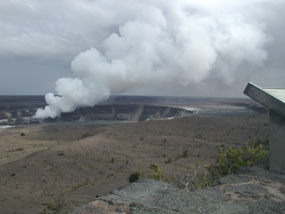Vog affects Big Island Crops, Visitors
Excerpt from the Honolulu Star Bulletin:
Big Island crops are shriveling as sulfur dioxide from Kilauea wafts over them and envelops them in "vog," or volcanic smog. People are wheezing and schoolchildren are being kept indoors during recess. High gas levels led Hawaii Volcanoes National Park to close several days this month, forcing the evacuation of thousands of visitors.
Residents of this volcanic island are used to toxic gas. But this haze is so bad that some farmers are thinking about growing different crops, and many people are worrying about their health.

The Vog has been particularly evident the past several months this summer. When the Trade Winds aren't present to dissipate them, the vog lingers more than ever and the usually clear, sunny skies of Kona are replaced with a hazy - almost overcast conditions. The vog makes outdoors activities less enjoyable and local tour guides like Ewa from Aloha Kayak Company thinks it is responsible for his drop in clientele.
Recent changes in volcanic activity at Halemaumau crater at the Kilauea summit have created potential health hazards for people with respiratory conditions and others on the island of Hawai‘i.
Government and private agencies are working together to monitor volcanic emissions and provide the most reliable information to help those affected make the best decisions for themselves and their families.
Changing and unpredictable conditions such as weather, wind direction and the amount of volcanic activity make it difficult to provide specific guidance for every situation. The Department of Health (DOH) advises Hawai‘i island residents to get updates and advisories on vog and volcanic emissions from the County of Hawai‘i Civil Defense local radio broadcasts and their website at www.scd.hawaii.gov.
Because of the hazardous activity of the eruption at Halemaumau Crater at the Volcanoes National Park, several portions of the Park are closed to the public for their safety. Check the Volcanoes National Park official website to check the status of the park and see which parts of the park are closed. The prevailing northeast tradewinds generally blow fumes from the volcano away from visitor areas. However, during times of weak winds or winds from the south (the opposite direction), volcanic fumes may impact visitor areas, prompting the park to close. Please be flexible and alert.
Big Island crops are shriveling as sulfur dioxide from Kilauea wafts over them and envelops them in "vog," or volcanic smog. People are wheezing and schoolchildren are being kept indoors during recess. High gas levels led Hawaii Volcanoes National Park to close several days this month, forcing the evacuation of thousands of visitors.
Residents of this volcanic island are used to toxic gas. But this haze is so bad that some farmers are thinking about growing different crops, and many people are worrying about their health.

The Vog has been particularly evident the past several months this summer. When the Trade Winds aren't present to dissipate them, the vog lingers more than ever and the usually clear, sunny skies of Kona are replaced with a hazy - almost overcast conditions. The vog makes outdoors activities less enjoyable and local tour guides like Ewa from Aloha Kayak Company thinks it is responsible for his drop in clientele.
Recent changes in volcanic activity at Halemaumau crater at the Kilauea summit have created potential health hazards for people with respiratory conditions and others on the island of Hawai‘i.
Government and private agencies are working together to monitor volcanic emissions and provide the most reliable information to help those affected make the best decisions for themselves and their families.
Changing and unpredictable conditions such as weather, wind direction and the amount of volcanic activity make it difficult to provide specific guidance for every situation. The Department of Health (DOH) advises Hawai‘i island residents to get updates and advisories on vog and volcanic emissions from the County of Hawai‘i Civil Defense local radio broadcasts and their website at www.scd.hawaii.gov.
Because of the hazardous activity of the eruption at Halemaumau Crater at the Volcanoes National Park, several portions of the Park are closed to the public for their safety. Check the Volcanoes National Park official website to check the status of the park and see which parts of the park are closed. The prevailing northeast tradewinds generally blow fumes from the volcano away from visitor areas. However, during times of weak winds or winds from the south (the opposite direction), volcanic fumes may impact visitor areas, prompting the park to close. Please be flexible and alert.

